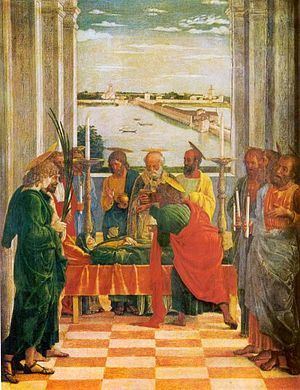Year 1462–1464 Dimensions 54 cm x 42 cm Created 1462–1464 | Location Museo Nacional Del Prado Subject Mary | |
 | ||
Type Tempera and gold on panel Media Panel painting, Tempera, Gold Similar Andrea Mantegna artwork, Artwork at Museo Nacional Del Prado, Tempera | ||
Caravaggio death of the virgin
The Death of the Virgin is a painting by the Italian Renaissance painter Andrea Mantegna, from c. 1462–1464.
Contents
In this picture Mantegna depicts the last moment of Mary's life within a space defined by classical architectures, with a squared pavement which leads the observer's eyes towards the bed on which the Virgin lies. In the background is a lake scene which is a detailed reproduction of the bridge and the burgh of the Castle of St. George in Mantua. The work was originally part of the decoration of the Castle chapel, together with three panels now in the Uffizi of Florence: the Adoration of the Magi, The Ascension and The Circumcision.
The unfinished appearance of the pilasters in the upper part of the picture suggests that it was once larger than it appears today. The fragment of Christ with the Virgin's Soul, now in Ferrara, was most likely part of the original composition.
